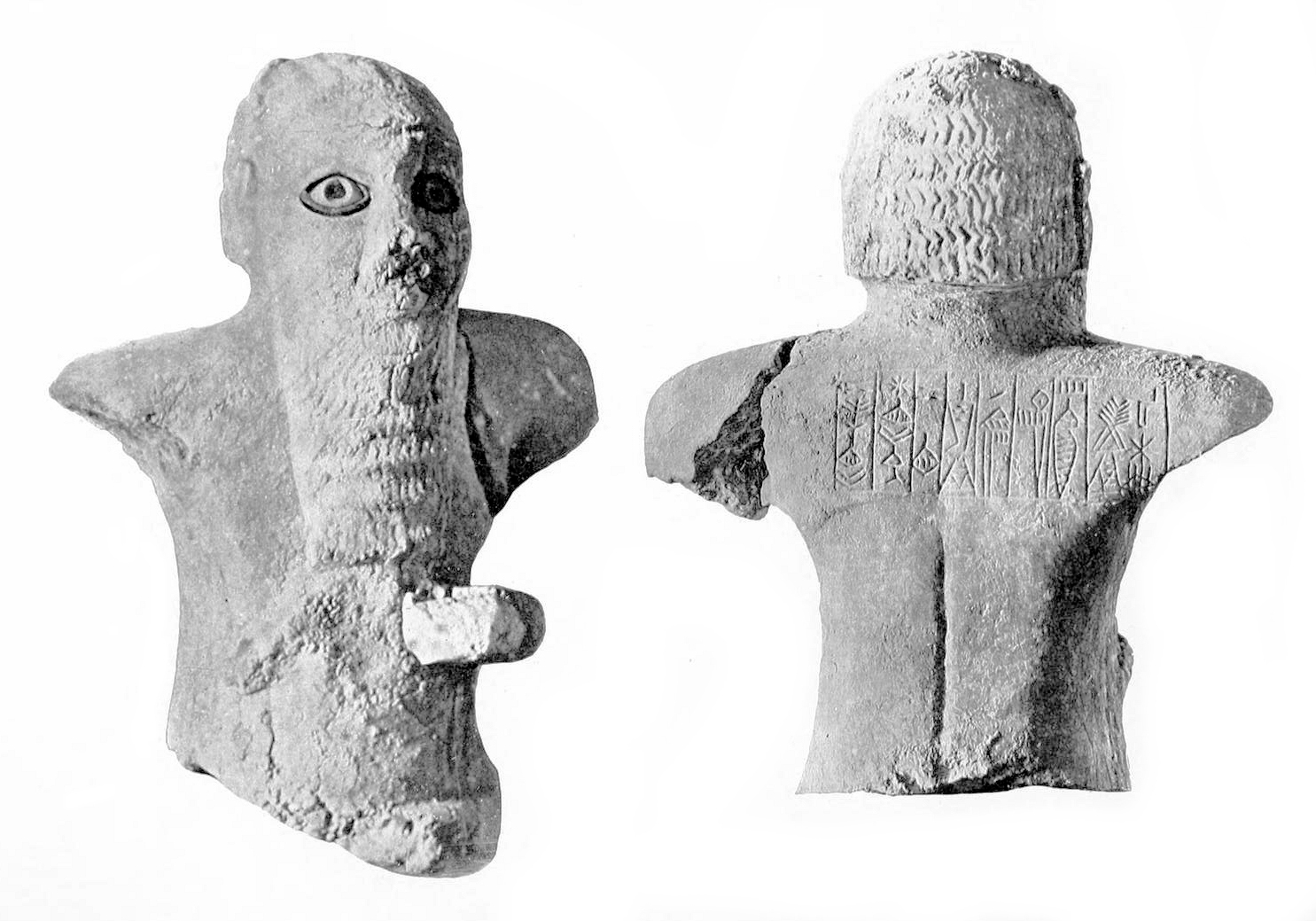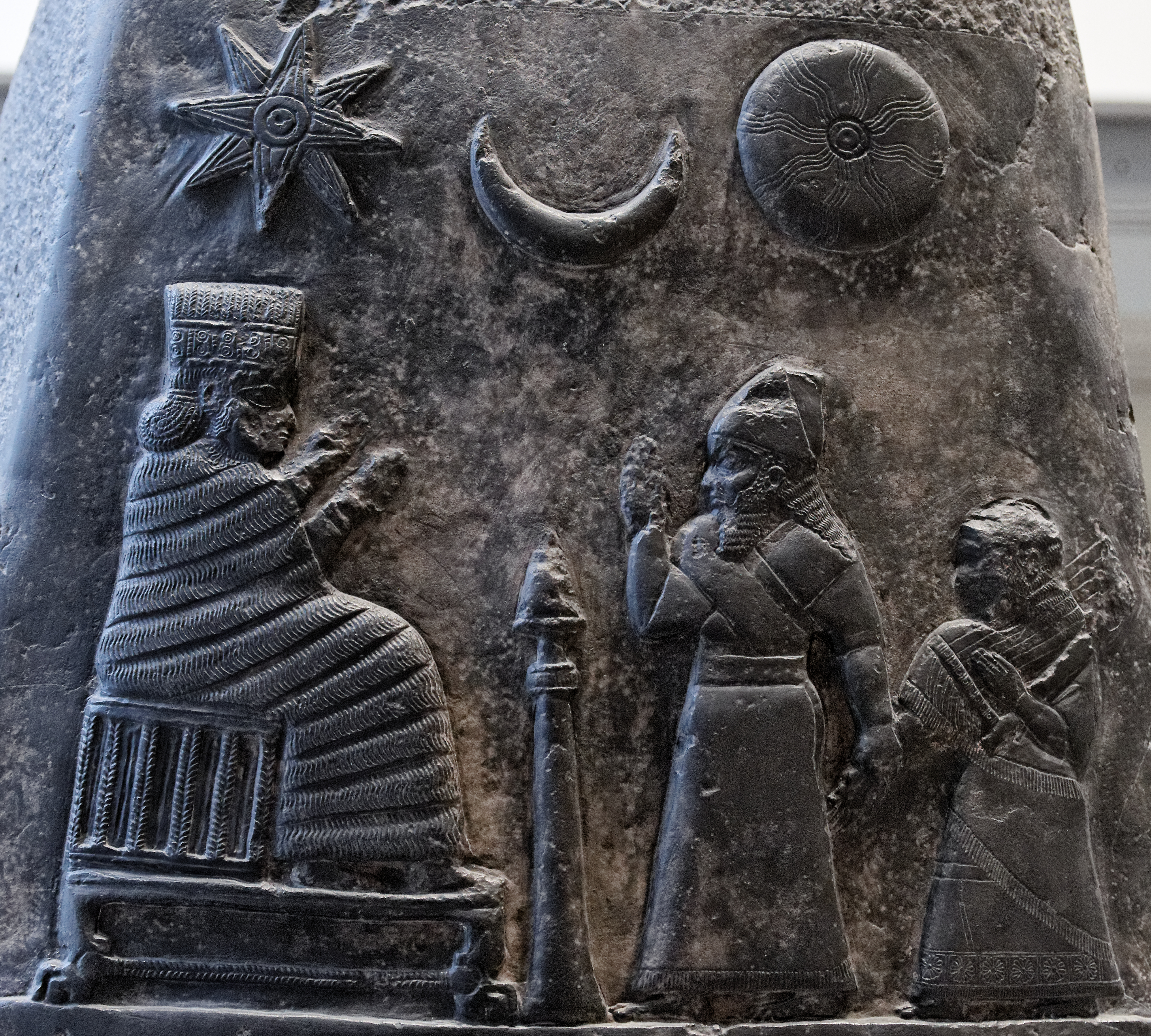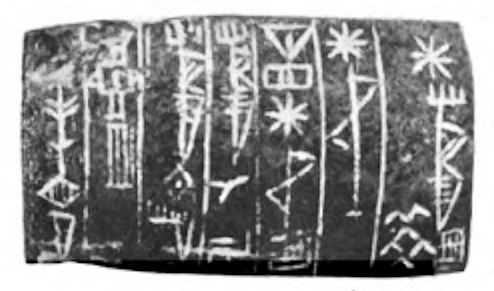|
Narunde
Narundi ( dna-ru-ti) or Narunde was an Elamite goddess worshiped in Susa. She is attested there roughly between 2250 BCE and 1800 BCE. Multiple inscriptions mention her, and it assumed she was a popular deity at the time. In later periods, she occurs exclusively in Mesopotamia, where she played a role in apotropaic rituals in association with the Sebitti. Many attestations are available from late Assyrian sources, but it is not certain if they should be regarded as an indication of continuous worship. In Elam Narundi is the oldest attested Elamite deity. She first appears in sources contemporaneous with the reign of the Akkadian Empire, and according to Javier Álvarez-Mon enjoyed a degree of popularity in the early periods. Heidemarie Koch suggested that she functioned as the goddess of victory. She was worshiped in Susa at least since around 2260 BCE, as indicated by a statue dedicated to her found in the so-called "Manishtushu shrine." Its style is characteristic for the Mes ... [...More Info...] [...Related Items...] OR: [Wikipedia] [Google] [Baidu] |
Sebitti
The Sebitti or Sebittu are a group of seven minor war gods in Neo-Sumerian, Akkadian, Babylonian and especially Assyrian tradition. They also appear in sources from Emar. Multiple different interpretations of the term occur in Mesopotamian literature. Description The word Sebitti and its multiple variations are typically translated with a meaning along the lines of "the seven", "group of seven" or "the seven of them". They are always presented as masculine deities, and are kin in one way or another (either brothers or half brothers). Their most prominent characteristic across all versions, is their warlike nature. Variations Assyriologist Frans Wiggermann enumerates the following known identities of this group: Anthropomorphized Pleiades The Sebitti can be anthropomorphic representation, of the Pleiades or another stellar or atmospheric phenomenon. Sons of Enmešarra The Sebitti can appear as sons of Enmešarra, a poorly known antagonistic figure known from some ... [...More Info...] [...Related Items...] OR: [Wikipedia] [Google] [Baidu] |
Puzur-Inshushinak
Puzur-Inshushinak (Linear Elamite: ''Puzur Sušinak''; Akkadian: , ''puzur3- dinšušinak'', also , ''puzur4- dinšušinak'' " Inshushinak (is) protection"; ), also sometimes thought to read Kutik-Inshushinak in Elamite, was a king of Elam, and the last from the Awan dynasty according to the Susa kinglist. He mentions his father's name as Šimpi-išhuk, which, being an Elamite name, suggests that Puzur-Inshuhinak himself was Elamite. Early life Under the Akkadian Empire (c. 2334-2154 BC), Elam had been a vassal since the time of Sargon. His father was Shinpi-khish-khuk, the crown prince, and most likely a brother of Khita. Kutik-Inshushinak's first position was as governor of Susa, which he may have held from a young age. Around 2150/2110 BC his father died, and he became crown prince in his stead. Reign Kutik-Inshushinak accordingly campaigned in the Zagros mountains on their behalf. He was greatly successful as his conquests seem to have gone beyond the initial mission. ... [...More Info...] [...Related Items...] OR: [Wikipedia] [Google] [Baidu] |
Cuneiform
Cuneiform is a Logogram, logo-Syllabary, syllabic writing system that was used to write several languages of the Ancient Near East. The script was in active use from the early Bronze Age until the beginning of the Common Era. Cuneiform scripts are marked by and named for the characteristic wedge-shaped impressions (Latin: ) which form their Grapheme, signs. Cuneiform is the History of writing#Inventions of writing, earliest known writing system and was originally developed to write the Sumerian language of southern Mesopotamia (modern Iraq). Over the course of its history, cuneiform was adapted to write a number of languages in addition to Sumerian. Akkadian language, Akkadian texts are attested from the 24th century BC onward and make up the bulk of the cuneiform record. Akkadian cuneiform was itself adapted to write the Hittite language in the early second millennium BC. The other languages with significant cuneiform Text corpus, corpora are Eblaite language, Eblaite, Elamit ... [...More Info...] [...Related Items...] OR: [Wikipedia] [Google] [Baidu] |
Mesopotamian Pantheon
Deities in ancient Mesopotamia were almost exclusively Anthropomorphism, anthropomorphic. They were thought to possess extraordinary powers and were often envisioned as being of tremendous physical size. The deities typically wore ''melam'', an ambiguous substance which "covered them in terrifying splendor" and which could also be worn by heroes, kings, giants, and even demons. The effect that seeing a deity's ''melam'' has on a human is described as ''ni'', a word for the "Paresthesia, physical creeping of the flesh". Both the Sumerian language, Sumerian and Akkadian languages contain many words to express the sensation of ''ni'', including the word ''puluhtu'', meaning "fear". Deities were almost always depicted wearing horned caps, consisting of up to seven superimposed pairs of ox-horns. They were also sometimes depicted wearing clothes with elaborate decorative gold and silver ornaments sewn into them. The ancient Mesopotamians believed that their deities lived in Heaven, ... [...More Info...] [...Related Items...] OR: [Wikipedia] [Google] [Baidu] |
Ninhursag
Ninḫursaĝ ( ''Ninḫarsang''; ), sometimes transcribed Ninursag, Ninḫarsag, or Ninḫursaĝa, also known as Damgalnuna or Ninmah, was the ancient Sumerian mother goddess of the mountains, and one of the seven great deities of Sumer. She is known earliest as a nurturing or fertility goddess. Temple hymn sources identify her as the "true and great lady of heaven" (possibly in relation to her standing on the mountain) and kings of Lagash were "nourished by Ninhursag's milk". She is the tutelary deity to several Sumerian leaders. Her best-known myths are ''Enki and Ninhursag'' describing her dealings with Enki resulting from his sexual exploits, and ''Enki and Ninmah'' a creation myth wherein the two deities compete to create humans. She is referenced or makes brief appearances in others as well, most notably as the mother of Ninurta in the Anzû Epic. Name Ninhursag means "lady of the sacred mountain" from Sumerian NIN "lady" and ḪAR.SAG̃ "sacred mountain, foothil ... [...More Info...] [...Related Items...] OR: [Wikipedia] [Google] [Baidu] |
Sin (mythology)
Sin () or Suen (, ) also known as Nanna ( ) is the Mesopotamian god representing the moon. While these two names originate in two different languages, respectively Akkadian language, Akkadian and Sumerian language, Sumerian, they were already used interchangeably to refer to one deity in the Early Dynastic Period (Mesopotamia), Early Dynastic period. They were sometimes combined into the double name Nanna-Suen. A third well attested name is Dilimbabbar (). Additionally, the name of the moon god could be represented by logograms reflecting his lunar character, such as d30 (), referring to days in the lunar month or dU4.SAKAR (), derived from a term referring to the crescent. In addition to his astral role, Sin was also closely associated with cattle herding. Furthermore, there is some evidence that he could serve as a judge of the dead in the Ancient Mesopotamian underworld, underworld. A distinct tradition in which he was regarded either as a god of equal status as the usual hea ... [...More Info...] [...Related Items...] OR: [Wikipedia] [Google] [Baidu] |
Enki
Enki ( ) is the Sumerian god of water, knowledge ('' gestú''), crafts (''gašam''), and creation (''nudimmud''), and one of the Anunnaki. He was later known as Ea () or Ae p. 324, note 27. in Akkadian (Assyrian-Babylonian) religion, and is identified by some scholars with Ia in Canaanite religion. The name was rendered Aos within Greek sources (e.g. Damascius). He was originally the patron god of the city of Eridu, but later the influence of his cult spread throughout Mesopotamia and to the Canaanites, Hittites and Hurrians. He was associated with the southern band of constellations called ''stars of Ea'', but also with the constellation AŠ-IKU, ''the Field'' ( Square of Pegasus). Beginning around the second millennium BCE, he was sometimes referred to in writing by the numeric ideogram for "40", occasionally referred to as his "sacred number". The planet Mercury, associated with Babylonian '' Nabu'' (the son of Marduk) was, in Sumerian times, identified with En ... [...More Info...] [...Related Items...] OR: [Wikipedia] [Google] [Baidu] |
Enlil
Enlil, later known as Elil and Ellil, is an List of Mesopotamian deities, ancient Mesopotamian god associated with wind, air, earth, and storms. He is first attested as the chief deity of the Sumerian pantheon, but he was later worshipped by the Akkadian Empire, Akkadians, Babylonian Empire, Babylonians, Assyrian Empire, Assyrians, and Hurrians. Enlil's primary center of worship was the Ekur temple in the city of Nippur, which was believed to have been built by Enlil himself and was regarded as the "mooring-rope" of heaven and earth. He is also sometimes referred to in Sumerian texts as Nunamnir. According to one Sumerian hymn, Enlil himself was so holy that not even the other gods could look upon him. Enlil rose to prominence during the twenty-fourth century BC with the rise of Nippur. His Cult (religious practice), cult fell into decline after Nippur was sacked by the Elamites in 1230 BC and he was eventually supplanted as the chief god of the Mesopotamian pantheon by the Baby ... [...More Info...] [...Related Items...] OR: [Wikipedia] [Google] [Baidu] |
Shamash
Shamash (Akkadian language, Akkadian: ''šamaš''), also known as Utu (Sumerian language, Sumerian: dutu "Sun") was the List of Mesopotamian deities, ancient Mesopotamian Solar deity, sun god. He was believed to see everything that happened in the world every day, and was therefore responsible for justice and protection of travelers. As a divine judge, he could be associated with the Ancient Mesopotamian underworld, underworld. Additionally, he could serve as the god of divination, typically alongside the weather god Adad. While he was universally regarded as one of the primary gods, he was particularly venerated in Sippar and Larsa. The Moon God, moon god Nanna (Sumerian deity), Nanna (Sin) and his wife Ningal were regarded as his parents, while his twin sister was Inanna (Ishtar). Occasionally other goddesses, such as Manzat (goddess), Manzat and Pinikir, could be regarded as his sisters too. The dawn goddess Aya (goddess), Aya (Sherida) was his wife, and multiple texts describe ... [...More Info...] [...Related Items...] OR: [Wikipedia] [Google] [Baidu] |
Nergal
Nergal ( Sumerian: d''KIŠ.UNU'' or ; ; Aramaic: ܢܸܪܓܲܠ; ) was a Mesopotamian god worshiped through all periods of Mesopotamian history, from Early Dynastic to Neo-Babylonian times, with a few attestations indicating that his cult survived into the period of Achaemenid domination. He was primarily associated with war, death, and disease, and has been described as the "god of inflicted death". He reigned over Kur, the Mesopotamian underworld, depending on the myth either on behalf of his parents Enlil and Ninlil, or in later periods as a result of his marriage with the goddess Ereshkigal. Originally either Mammitum, a goddess possibly connected to frost, or Laṣ, sometimes assumed to be a minor medicine goddess, were regarded as his wife, though other traditions existed, too. His primary cult center was Kutha, located in the north of historical Babylonia. His main temple bore the ceremonial name E-Meslam and he was also known by the name Meslamtaea, "he who comes ... [...More Info...] [...Related Items...] OR: [Wikipedia] [Google] [Baidu] |
Inanna
Inanna is the List of Mesopotamian deities, ancient Mesopotamian goddess of war, love, and fertility. She is also associated with political power, divine law, sensuality, and procreation. Originally worshipped in Sumer, she was known by the Akkadian Empire, Akkadians, Babylonian religion, Babylonians, and Assyrians as Ishtar. Her primary title is Queen of Heaven (antiquity), "the Queen of Heaven". She was the patron goddess of the Eanna temple at the city of Uruk, her early main religious center. In archaic Uruk, she was worshipped in three forms: morning Inanna (Inana-UD/hud), evening Inanna (Inanna sig), and princely Inanna (Inanna NUN), the former two reflecting the phases of her associated planet Venus. Her most prominent symbols include the Lion of Babylon, lion and the Star of Ishtar, eight-pointed star. Her husband is the god Dumuzid (later known as Tammuz), and her (attendant) is the goddess Ninshubur, later conflated with the male deities Ilabrat and Papsukkal. Inanna ... [...More Info...] [...Related Items...] OR: [Wikipedia] [Google] [Baidu] |







